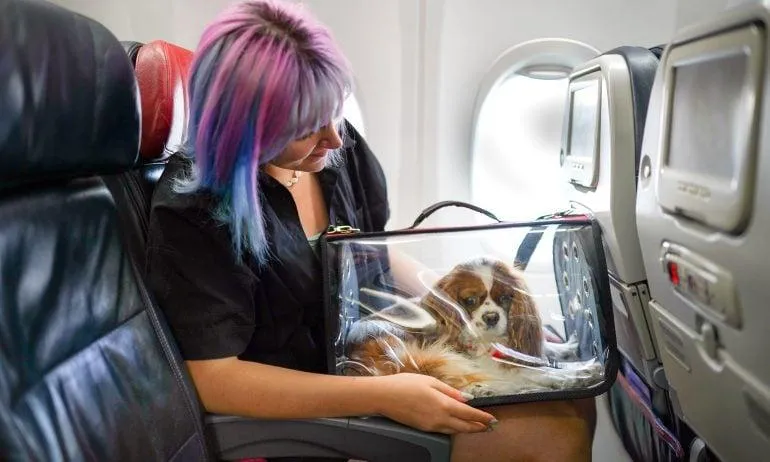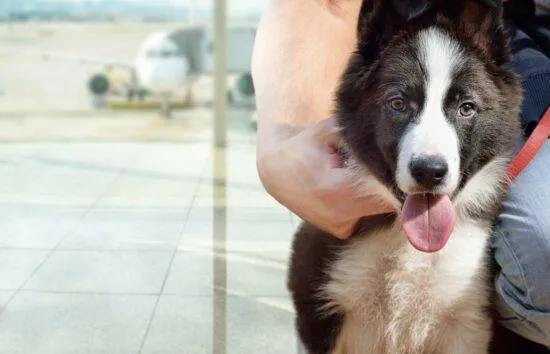Flying with Your Large Dog: Everything You Need to Know
As a frequent flyer with large dogs, I get asked this question a lot: is it possible to fly with a big canine companion, and what do you need to do to make it happen smoothly? In this article, I’ll outline everything I’ve learned over the years about flying with large dogs—from airline size and weight restrictions to tips for keeping Fido calm and comfortable in the airport and on the plane.
Check Airlines’ Pet Policies
The first step is researching the pet policies for your preferred airline or any airlines serving your route. Major carriers like Delta, American, and United have size and weight limits that need to be met for dogs to travel in the aircraft cabin rather than as cargo. For example, Delta allows dogs under 20 pounds to sit in a carrier under the seat, while dogs over 20 pounds fly in cargo unless they are service or support animals.
But size limits vary, so be sure to verify each airline’s rules, especially if your dog is over 20 pounds. Some, like Alaska Airlines, allow dogs up to 100 pounds in-cabin if you purchase an extra seat for them. Always check pet policies and fees before booking your flights!
Purchase a Sturdy Travel Carrier
An FAA-approved hard-sided carrier is absolutely necessary for transporting a large dog on a plane. Soft-sided carriers don’t provide enough protection. Look for something roomy but still allowed as a personal item or carry-on under the seat in front of you. I like the Petmate Sky Kennel—it’s tough, allows plenty of standing room, and most airlines approve it.
Get Your Dog Used to the Carrier
- Start feeding meals inside the empty carrier to get positive associations.
- Put treats and toys in the carrier so it’s a fun place to hang out.
- Practice short training sessions inside with the door closed until they’re totally calm inside.
This gradual desensitization can take weeks, so start early. The last thing you want is a stressed-out pup on moving day!

Prepare Travel Documents
airlines require a veterinary health certificate and proof of vaccinations that are generally valid for entry into destination countries too. I keep my dogs’ files organized and bring multiple hard copies of all docs just in case. A digital backup on your phone is handy as well.
Sedation May Be Necessary
While it’s possible to fly without medication for some mellow large dogs, there are a few things to consider if sedation could help your pooch stay relaxed:
- Talk to your vet—get a mild sedative prescription if your dog tends to be anxious or vocal during travel.
- Give the medication 30-60 minutes before arriving at the airport to take full effect during security screening, check-in, etc.
- Bring an edible treat high in protein that can be given mid-flight if the dog seems to be waking up.
Just be sure not to overmedicate, as safety is key. Light sedation is usually best for keeping Canine calm without totally zonking them out.
Prepare For Delays
Even with the best of plans, delays can and do happen when flying—so I always pack backups just in case. Extra water, a leash, poop bags, and high-value treats go in my carry-on to keep pup happy if we end up stuck on the tarmac or in an airport for a prolonged period. A portable bowl, favorite toy, and Ziplocs with a clean airline crate paper also help make waiting more comfortable.
Strategies For Security Screening
Clearing security with a large dog can require some skill! Here are my top tips:

- Request a pat-down for your dog rather than going through the body scanner, which may stress them out.
- Bring paper or a blanket from home for your dog to lie on during screening so they feel more at ease.
- Be prepared to lift your dog and carrier over conveyor belts or demonstrate items are empty by evenly dispersing treats in the carrier for TSA to see inside.
Having treats on hand for positive reinforcement and staying calm yourself are key to a smooth screening experience.
Boarding The Plane
Many airlines will pre-board passengers with pets, so watch boarding signs and listen for your row to be called. I like to get settled with my dog beneath the seat then give a high-value chewy treat or bone for them to focus on during takeoff and landing. Some crews may ask to verify your dog is secured before moving the jet way.
In-Flight Comforts
On longer flights, I try to give my large dog short frequent bathroom breaks if possible when the Fasten Seatbelt sign is off. A leash and poo bags are a must for this! Consider bringing an eye mask or white noise app too if your pup gets anxious during turbulence. And make sure to hydrate them along the way.
Preparing For Arrival
Nearly there! Before landing, I like to give treats sparingly en route to baggage claim then let my dog potty outside arrivals as a positive final experience. Double check carry-on tags are attached and you have all documents ready for customs. A successful flight awaits with some advance planning and TLC for your four-legged friend!
In summary, flying with large dogs is very doable when you follow airline guidelines, thoroughly prepare your pup, and remain calm yet vigilant yourself throughout the journey. Safe travels to all dog owners! Let me know if you have any other questions.

Factors to Consider When Flying With Your Large Dog
| Factor | Details |
|---|---|
| Dog Breed | Certain large breeds like Great Danes may have difficulty fitting under an airline seat. |
| Dog Size | Measure your dog and check carrier size limits. Most airlines require dogs fit in carriers no more than 18 inches high by 23 inches long. |
| Airline Policies | Rules vary by airline but most only allow one dog per person traveling. Check on advance notice, health form, and carrier requirements. |
| Direct or Connecting Flight | Direct flights are less stressful for dogs. Connections increase risk of delays or missed connections. |
| Cabin or Cargo | Cabin is safer for dogs but cargo may be only option if dog is too large. No cargo in warm weather. |
| Cost | Expect fees for cabin or cargo travel. Prices vary but can be $100-300 each way depending on airline and route. |
FAQ
-
Will a large dog be happy flying long trips in a plane?
Basically, most big pups will not exactly love a long flight in a plane. It depends on the dog’s personality and training. With proper preparation and care on the journey, a large canine may kind of enjoy the experience. At the same time, it could be very stressful for some dogs.
-
What precautions should I take when flying with a large dog?
You’ll need to take your big buddy in a secure dog carrier that fits under the seat in front of you. Also, make sure Fido has stayed well hydrated and rested before the flight. Don’t forget documents like vet records in case the airline asks for proof of vaccinations. Do some training at home so your large lambchop is accustomed to the carrier.
-
Is it allowed to bring a large service dog on a plane?
Yes, under the Americans with Disabilities Act, airlines must permit service dogs onboard – regardless of size. These good pups help their owners with essential tasks. The airline may ask for documentation that proves it’s a service animal. But otherwise, a great dane is just as welcome as a lapdog!
-
“Will a big dog be uncomfortable in the cargo hold?”
Perhaps packing a huge hound below with luggage seems not quite right. The cargo hold can get loud and cold. Despite tight spacing, some airlines do okay transporting dogs down there. But many vets argue it’s better if possible to keep larger pups in the cabin where it’s calmer and closer to their person.
What size dog is too big for the cabin?
Usually, if the pooch can fit safely inside an FAA-required carrier that slides under the seat, their size should basically be alright. Most major airlines allow dogs up to around 20 inches tall. But each carrier has a weight limit too – typically around 20 pounds. Anything much bigger than that may have to ride cargo based on the plane type.

“What if my big pup is afraid to fly?”
Flying a skeptical sump can seem kinda scary. If they’re fearful, ask the vet about calming aids before boarding. You could also try practicing getting your enormous mutt accustomed to the carrier at home. Maybe play repeating airplane sounds to get them used to the noise. On the flight, comfort and reassure your quivering quadruped as best as you can.
In the end, is it worth it to fly with an enormous dog?
There are definite pros and cons to consider. While not ideal for every huge hound, flying can be an okay option for some well-trained large dogs if handled properly. Riding along might make a long-distance move less stressful than going by car or shipping solo. But is worrying about your enormous pup’s welfare worth the cost and hassle? Only you can decide if flying a large lambchop is truly the right choice!
